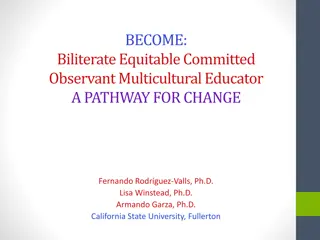Understanding Cultural Competence in Extension Education
Culturally competent extension educators need to have knowledge of history, culture, traditions, customs, and more to effectively engage with diverse communities. By recognizing biases and learning about different cultures, educators can promote positive characteristics and strengths within communities. Communication styles vary across cultures, emphasizing the importance of understanding and adapting to different communication preferences.
Download Presentation

Please find below an Image/Link to download the presentation.
The content on the website is provided AS IS for your information and personal use only. It may not be sold, licensed, or shared on other websites without obtaining consent from the author. Download presentation by click this link. If you encounter any issues during the download, it is possible that the publisher has removed the file from their server.
E N D
Presentation Transcript
Dallas L. Holmes EdD, USU Extension Adapted from Lisa A. Guion and Kay Brown, Florida State University Cooperative Extension, 2010. CULTURALLY COMPETENT EXTENSION EDUCATORS
Cultural Competence Knowledge of History Culture Traditions Customs Language Dialect Values Religious or Spiritual Beliefs Art Music Learning Styles Practices of Individuals Roles Family Hierarchies Expressions of politeness Communication patterns
Cultural Competence Respecting and learning about culture promotes a focus on the positive characteristics and strengths of a community and the individuals that reside within it. Okun, Fried, & Okun, 1999
Cultural Competence In order for Extension Educators to be culturally competent, they must first recognize their ownbiases and preconceptions. It then becomes easier to disregard those biases and learn about others in a non- judgmental way.
Cultural Competency Communication Every culture has its own communication style. direct versus indirect verbal versus nonverbal high context versus low context circular versus linear formal versus informal expressive versus stoic
Cultural Competency Communication How do Euro- Americans communicate? Verbal/Non-verbal Expressive/Stoic Linear/Circular High context/ Low context Formal/Informal
Cultural Competency Communication What are characteristics of Latin Communication styles? Verbal/Non-verbal Expressive/Stoic Linear/Circular High context/Low context Formal/Informal
Cultural Competency Communication What are characteristics of Native American Communication styles? Verbal/Non-verbal Expressive/Stoic Linear/Circular High context/Low context Formal/Informal
Cultural Competency Communication Awareness of one s own cultural communication style and awareness of other valid cultural communication styles reflect different perceptions, assumptions, norms, beliefs and values. Schauber & Castania
Cultural Competency Communication Requires an understanding of: Historical Power Differences (i.e. Slavery) Present Day behaviors that result from the history of that group s survival (i.e. Russians external coldness is a result of the Stalin era when they were under surveillance) Ability to empathize cross-culturally (i.e. The European Union is a geographically small area with great diversity they learn cultural empathy and tolerance quickly).
Cultural Competency Communication Requirements, continued Acceptance of multiple perspectives (i.e. Gandhi s mediation between the British, Hindu and Muslim all vying for power in India) Observation while reserving judgments. Adaptation of one s communication style to others (i.e. Native Americans and early European settlers interactions)
Cultural Competency Communication There are many resources available to assist in developing culturally appropriate communication. The best way is to actually DO it! Interact with culturally diverse people, their families, their religion, their language and their communities.
Resources Strengthening Programs to Reach Diverse Audiences: http://fycs-diversity.ifas.ufl.edu National Extension Diversity Center: http://www.ediversitycenter.net/ Teachers Corner EdChange Multicultural Pavilion: http://www.edchange.org/multicultural/teach ers.html
References Corey, M.S., & Corey, G. (2003). Becoming a helper. Pacific Grove, CA: Brooks/Cole. Dresser, N. (1996). Multicultural manners: New rules of etiquette for a changing society. New York: Wiley. Guion, L.A., Chattaraj, S.C. & Lytle, S.S. (2005). A Conceptual framework for connecting across cultures. Journal of Family and Consumer Sciences, 97(1), 76-82. Okun, B., Fried, J. & Okun, M. (1999). Understanding Diversity: A learning-as-practice primer. Pacific Grove, CA: Brooks/Cole.























